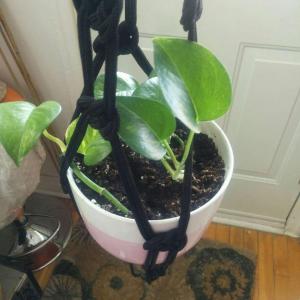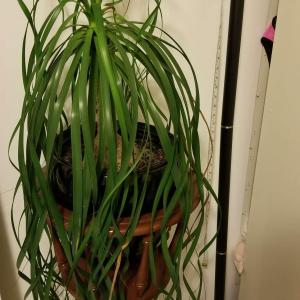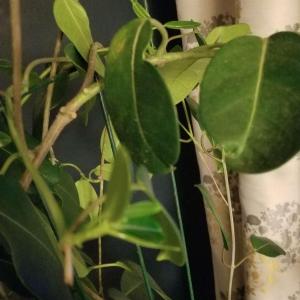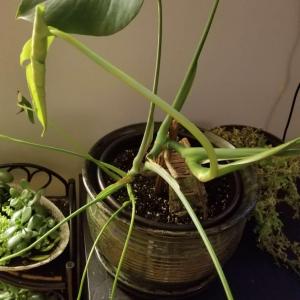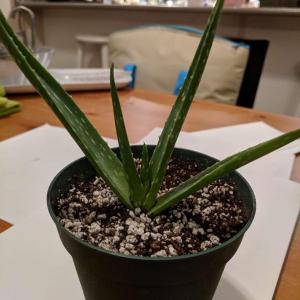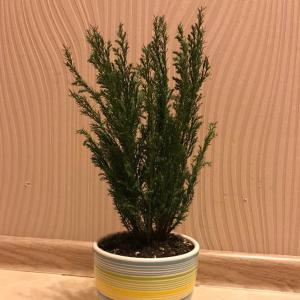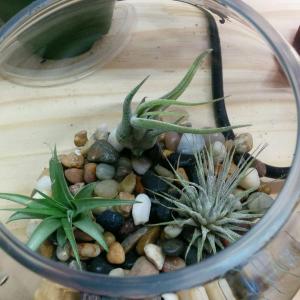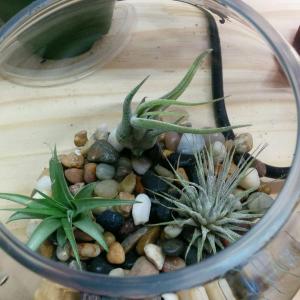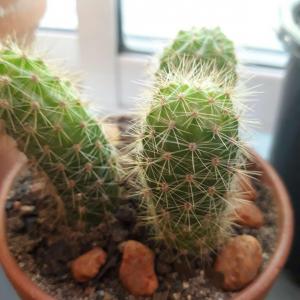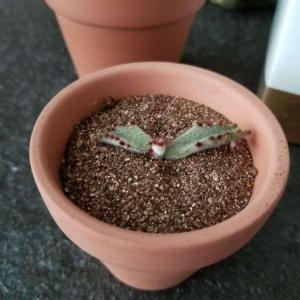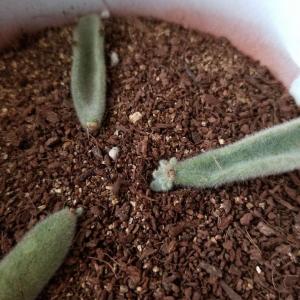文章
Miss Chen
2018年02月07日

Description: This annual plant is about 2' tall and largely unbranched, except near the base. The major stems are stout, round, and covered with rather long glandular hairs, especially where new growth occurs. The lower and middle compound leaves along the stems are trifoliate with long petioles. The individual leaflets are about 1½" long and ½" across. They are oval, ovate, or oblong, and have smooth margins that are slightly ciliate. Their surface is dull green and covered with short fuzzy hairs, with longer hairs occurring along the lower central vein. When the foliage is bruised or rubbed against, a fetid odor is emitted. Smaller leaves on short petioles occur along the upper stems that are simple, rather than compound. The major stems terminate in racemes of flowers of variable length – these flowers are whorled near the apex of the stems with scattered seedpods below. Each flower is about 1" across and has an unusual structure. There are 4 white petals about ½" long that are heart-shaped, but with a long narrow base. About 8-12 strongly exerted stamens are reddish purple and rather unequal in length, with the upper stamens about twice the length of the petals. The single slender style is much shorter than the stamens and less conspicuous. At the base of each flower, is a gland that secretes a conspicuous drop of bright red fluid. The calyx is divided into 4 triangular sepals that are reddish purple. The flowers occur on long hairy pedicels.
The blooming period occurs from summer until the fall, and can last several months. There is no obvious floral scent. Pollinated flowers develop sizeable seedpods up to 3" long that are sessile against the pedicels (i.e., there is no stipular growth at the base of the seedpods). These seedpods resemble stout bean pods that can divide into two halves. Each seedpod has fuzzy hairs on the outer surface, and forms a long terminal spike that withers away as the seedpod matures. Mature seedpods are held more or less erect, rather than drooping downward from the stems. The individual seeds have an irregular patterned surface. The root system consists of a long taproot without rhizomes. This plant spreads by reseeding itself.
Cultivation: It is best to growth this plant in full sunlight, mesic to dry conditions, and soil that is rocky or sandy. The base of the central stem of this plant may sprawl along the ground if it is grown in moist, fertile soil. Foliar disease and insect pests are not generally troublesome.

Range & Habitat: Large-Flowered Clammyweed is an uncommon plant that occurs in widely scattered counties in Illinois (see Distribution Map), where it is probably native. This plant is more common in areas that lie to the west of Illinois. Within the state, it has been found in such natural habitats as openings in bluffs, glades, or hill prairies, and may occur occasionally as an adventive plant along railroads. Because of the ornamental flowers, this plant can be found in flower gardens, but this is uncommon.
Faunal Associations: Various bees visit the flowers for nectar, while flower flies feed on the pollen from the exerted anthers. However, the latter group of insects does not effectively pollinate the flowers. The foliage is not known to be toxic to mammalian herbivores, notwithstanding the fetid odor, but little appears to be known about the attractiveness of the foliage as a food source. Similarly, little is known about the attractiveness of the seeds to small rodents or upland gamebirds. Because the seeds of similar kinds of plants, such as the Cleome spp. (Bee Plants) in the western states, are occasionally eaten by the Ring-Necked Pheasant, Mourning Dove, and various small rodents, it is possible that the same or similar species also eat the seeds of Polanisia spp. (Clammyweeds).

Photographic Location: The edge of vegetable garden in Meadowbrook Park, Urbana, Illinois. The plant was blooming during early September.
Comments: Large-Flowered Clammyweed is primarily a western species, and Illinois lies on the eastern edge of its distribution. It is fairly attractive while in bloom and has some resemblance to Cleome hassleriana (Spider Flower) of mass-market horticulture. This latter species is a larger plant from South America with palmate compound leaves. The more typical variety of Clammyweed, Polanisia dodecandra dodecandra, has smaller flowers with petals about ¼" and stamens that are barely longer than the petals. It less showy than the variety of Clammyweed that is described here, and it has a more eastern distribution. An uncommon species of Clammyweed, Polanisia jamesii (James' Clammyweed), is a sand prairie species that has narrow leaflets and flower petals with irregular fringed edges. What distinguishes the Polanisia spp. (Clammyweeds) from the Cleome spp. (Bee Plants) is the lack of a stipe connecting the seedpod with the pedicel. This stipe of the Bee Plants is a stalk-like extension of the developing seedpod. Both groups of plants are members of the Caper family.
The blooming period occurs from summer until the fall, and can last several months. There is no obvious floral scent. Pollinated flowers develop sizeable seedpods up to 3" long that are sessile against the pedicels (i.e., there is no stipular growth at the base of the seedpods). These seedpods resemble stout bean pods that can divide into two halves. Each seedpod has fuzzy hairs on the outer surface, and forms a long terminal spike that withers away as the seedpod matures. Mature seedpods are held more or less erect, rather than drooping downward from the stems. The individual seeds have an irregular patterned surface. The root system consists of a long taproot without rhizomes. This plant spreads by reseeding itself.
Cultivation: It is best to growth this plant in full sunlight, mesic to dry conditions, and soil that is rocky or sandy. The base of the central stem of this plant may sprawl along the ground if it is grown in moist, fertile soil. Foliar disease and insect pests are not generally troublesome.

Range & Habitat: Large-Flowered Clammyweed is an uncommon plant that occurs in widely scattered counties in Illinois (see Distribution Map), where it is probably native. This plant is more common in areas that lie to the west of Illinois. Within the state, it has been found in such natural habitats as openings in bluffs, glades, or hill prairies, and may occur occasionally as an adventive plant along railroads. Because of the ornamental flowers, this plant can be found in flower gardens, but this is uncommon.
Faunal Associations: Various bees visit the flowers for nectar, while flower flies feed on the pollen from the exerted anthers. However, the latter group of insects does not effectively pollinate the flowers. The foliage is not known to be toxic to mammalian herbivores, notwithstanding the fetid odor, but little appears to be known about the attractiveness of the foliage as a food source. Similarly, little is known about the attractiveness of the seeds to small rodents or upland gamebirds. Because the seeds of similar kinds of plants, such as the Cleome spp. (Bee Plants) in the western states, are occasionally eaten by the Ring-Necked Pheasant, Mourning Dove, and various small rodents, it is possible that the same or similar species also eat the seeds of Polanisia spp. (Clammyweeds).

Photographic Location: The edge of vegetable garden in Meadowbrook Park, Urbana, Illinois. The plant was blooming during early September.
Comments: Large-Flowered Clammyweed is primarily a western species, and Illinois lies on the eastern edge of its distribution. It is fairly attractive while in bloom and has some resemblance to Cleome hassleriana (Spider Flower) of mass-market horticulture. This latter species is a larger plant from South America with palmate compound leaves. The more typical variety of Clammyweed, Polanisia dodecandra dodecandra, has smaller flowers with petals about ¼" and stamens that are barely longer than the petals. It less showy than the variety of Clammyweed that is described here, and it has a more eastern distribution. An uncommon species of Clammyweed, Polanisia jamesii (James' Clammyweed), is a sand prairie species that has narrow leaflets and flower petals with irregular fringed edges. What distinguishes the Polanisia spp. (Clammyweeds) from the Cleome spp. (Bee Plants) is the lack of a stipe connecting the seedpod with the pedicel. This stipe of the Bee Plants is a stalk-like extension of the developing seedpod. Both groups of plants are members of the Caper family.
0
0
文章
Miss Chen
2018年01月09日

For gardeners new to spring bulbs, daffodils (Narcissus spp.) are a bright gift. Hardy between U.S. Department of Agriculture plant hardiness zones 3 through 10, depending on species, daffodils are less appetizing to winter grazing rodents -- and more reliable perennials -- than many other spring bulbs. They come in a variety of forms and coloration. A well-chosen collection of early-, mid- and late-season varieties will brighten your garden throughout the spring.

Mystery of the Bulb
Daffodil bulbs, like other tunicate bulbs, wear a protective layer of dried skin, or tunic, that helps insulate and keep bulbs moist. The thick layers underneath the tunic anchor this year's plant but also contain the embryo of a succeeding plant, flower and all, and enough nutritious material to keep it healthy until it is time for it to bloom, hopefully next spring. The bulb protects the growing flower from heat, drought and freezing weather.
The bulb never stops growing. It adds layers and processes and stores nutrients year-round. This prepares its hardy little occupant for the vicissitudes of unpredictable spring weather. It might even pop up through the last melting snow if conditions are right.
The Right Conditions
Every daffodil has its own rhythm to follow. Growth responds to daylight and soil temperature. Daffodils come to life when soil temperatures range from 50 to 60 degrees Fahrenheit and as the sun rises and days lengthen. Each year brings a slightly different progression, so bloom times may vary by days or weeks from one year to another.

Early varieties such as February Gold (Narcissus 'February Gold,' USDA zones 4 to 8) and Ice Follies (Narcissus 'Ice Follies,' USDA zones 3 to 8) bloom, as their names suggest, as winter fades into very early spring. Tete-a-Tete (Narcissus 'Tete-a-Tete,' USDA zones 4 to 8) may bloom as early as February in warmer southern zones, but wait until March further north.
Mid-season begins in March in southern zones, but in cooler zones Jack Snipe (Narcissus 'Jack Snipe,' USDA zones 4 to 8), Trevithian (Narcissus 'Trevithian,' USDA zones 5 to 10) and many of the big mid-season trumpet "daffs" bloom throughout April.
Late varieties such as Salome (Narcissus 'Salome,' USDA zones 3 to 9) may bloom as late as mid-May in the north.
About Chilling
Many daffodils depend on winter chilling to keep their bloom time on track. They typically require temperatures between 35 and 48 degrees Fahrenheit for 12 to 18 weeks depending on variety -- not a problem for bulbs planted in fall in northern zones. Gardeners in USDA zone 8 and further south dig and dry bulbs with long chilling requirements after foliage dies down in summer and keep them in cool storage for three to four months before replanting. Gardeners in warmer zones can plant native daffodils such as tazetta daffodils (Narcissus 'Minnow,' USDA zones 5 through 9) that do not require lengthy chilling.
The Prolific Perennial
Daffodils are reliably perennial and will produce daughter bulbs along their bases. Separate these bulbs every two or three years after their foliage has died down in early summer. Just lay bulbs out in cool shade to dry. Pull off the daughter bulbs and plant them in sunny, well-drained soil come fall.

Mystery of the Bulb
Daffodil bulbs, like other tunicate bulbs, wear a protective layer of dried skin, or tunic, that helps insulate and keep bulbs moist. The thick layers underneath the tunic anchor this year's plant but also contain the embryo of a succeeding plant, flower and all, and enough nutritious material to keep it healthy until it is time for it to bloom, hopefully next spring. The bulb protects the growing flower from heat, drought and freezing weather.
The bulb never stops growing. It adds layers and processes and stores nutrients year-round. This prepares its hardy little occupant for the vicissitudes of unpredictable spring weather. It might even pop up through the last melting snow if conditions are right.
The Right Conditions
Every daffodil has its own rhythm to follow. Growth responds to daylight and soil temperature. Daffodils come to life when soil temperatures range from 50 to 60 degrees Fahrenheit and as the sun rises and days lengthen. Each year brings a slightly different progression, so bloom times may vary by days or weeks from one year to another.

Early varieties such as February Gold (Narcissus 'February Gold,' USDA zones 4 to 8) and Ice Follies (Narcissus 'Ice Follies,' USDA zones 3 to 8) bloom, as their names suggest, as winter fades into very early spring. Tete-a-Tete (Narcissus 'Tete-a-Tete,' USDA zones 4 to 8) may bloom as early as February in warmer southern zones, but wait until March further north.
Mid-season begins in March in southern zones, but in cooler zones Jack Snipe (Narcissus 'Jack Snipe,' USDA zones 4 to 8), Trevithian (Narcissus 'Trevithian,' USDA zones 5 to 10) and many of the big mid-season trumpet "daffs" bloom throughout April.
Late varieties such as Salome (Narcissus 'Salome,' USDA zones 3 to 9) may bloom as late as mid-May in the north.
About Chilling
Many daffodils depend on winter chilling to keep their bloom time on track. They typically require temperatures between 35 and 48 degrees Fahrenheit for 12 to 18 weeks depending on variety -- not a problem for bulbs planted in fall in northern zones. Gardeners in USDA zone 8 and further south dig and dry bulbs with long chilling requirements after foliage dies down in summer and keep them in cool storage for three to four months before replanting. Gardeners in warmer zones can plant native daffodils such as tazetta daffodils (Narcissus 'Minnow,' USDA zones 5 through 9) that do not require lengthy chilling.
The Prolific Perennial
Daffodils are reliably perennial and will produce daughter bulbs along their bases. Separate these bulbs every two or three years after their foliage has died down in early summer. Just lay bulbs out in cool shade to dry. Pull off the daughter bulbs and plant them in sunny, well-drained soil come fall.
0
0
文章
Miss Chen
2018年01月02日

Lily (Lilium) bulbs multiply continuously, hidden under the soil. Each spring, new flowers come up reliably, even if you neglected them through the year. But, every few years, lilies need to be divided and transplanted, otherwise they get overcrowded, resulting in fewer flowers and weak plant growth. Lilies grow in U.S. Department of Agriculture plant hardiness zones 4 through 8.

When to Divide Lilies
When growing lilies, it's best to let them grow undisturbed as long as they are flowering reliably. In general, plan to divide lilies about every three years, or when when you notice an overall reduction in flowers and spindly weak-looking stems. Lily bulbs produce small offsets that grow into full-size bulbs. As the bulbs multiply, it causes overcrowding in the growing area. Plan to separate and transplant lilies in early fall, after the flowers fade and the leaves start to die back.
Digging Lilies
Use a garden fork to dig under the bulbs and lift them from the soil. Lily bulbs grow right below the leaf stalk, so you can dig 3 to 6-inches from the edge of the clump without damaging the main bulbs. Shake of the excess soil to expose the bulbs. Gently pull the clump apart to expose the individual bulbs. Use your fingers to untangle the roots.
Dividing Bulbs
Hold the lily bulb and identify the smaller offset growing out from the side. They will be connected at the base. Gently break the smaller bulb from the larger bulb. Ideally you should replant immediately, but you can store lily bulbs until spring if replanting right away isn't convenient. To store, pack lily bulbs in damp peat moss and place them in a plastic bag. Keep the bulbs in the refrigerator until you are ready to plant.

Transplanting
You can replant all the lily bulbs in the original spot spreading them out to avoid overcrowding, or move some to a new garden area. Lilies grow best in full sun and soil with good drainage. Dig holes for each bulb two to three times deeper than the height of the bulb. Place one lily bulb in each hole with the flat side down and the pointed side up. Push the soil over the bulb and pat it down gently. Space each lily bulb 12 to 18 inches apart. After you are finished planting, water the area.

When to Divide Lilies
When growing lilies, it's best to let them grow undisturbed as long as they are flowering reliably. In general, plan to divide lilies about every three years, or when when you notice an overall reduction in flowers and spindly weak-looking stems. Lily bulbs produce small offsets that grow into full-size bulbs. As the bulbs multiply, it causes overcrowding in the growing area. Plan to separate and transplant lilies in early fall, after the flowers fade and the leaves start to die back.
Digging Lilies
Use a garden fork to dig under the bulbs and lift them from the soil. Lily bulbs grow right below the leaf stalk, so you can dig 3 to 6-inches from the edge of the clump without damaging the main bulbs. Shake of the excess soil to expose the bulbs. Gently pull the clump apart to expose the individual bulbs. Use your fingers to untangle the roots.
Dividing Bulbs
Hold the lily bulb and identify the smaller offset growing out from the side. They will be connected at the base. Gently break the smaller bulb from the larger bulb. Ideally you should replant immediately, but you can store lily bulbs until spring if replanting right away isn't convenient. To store, pack lily bulbs in damp peat moss and place them in a plastic bag. Keep the bulbs in the refrigerator until you are ready to plant.

Transplanting
You can replant all the lily bulbs in the original spot spreading them out to avoid overcrowding, or move some to a new garden area. Lilies grow best in full sun and soil with good drainage. Dig holes for each bulb two to three times deeper than the height of the bulb. Place one lily bulb in each hole with the flat side down and the pointed side up. Push the soil over the bulb and pat it down gently. Space each lily bulb 12 to 18 inches apart. After you are finished planting, water the area.
0
0








